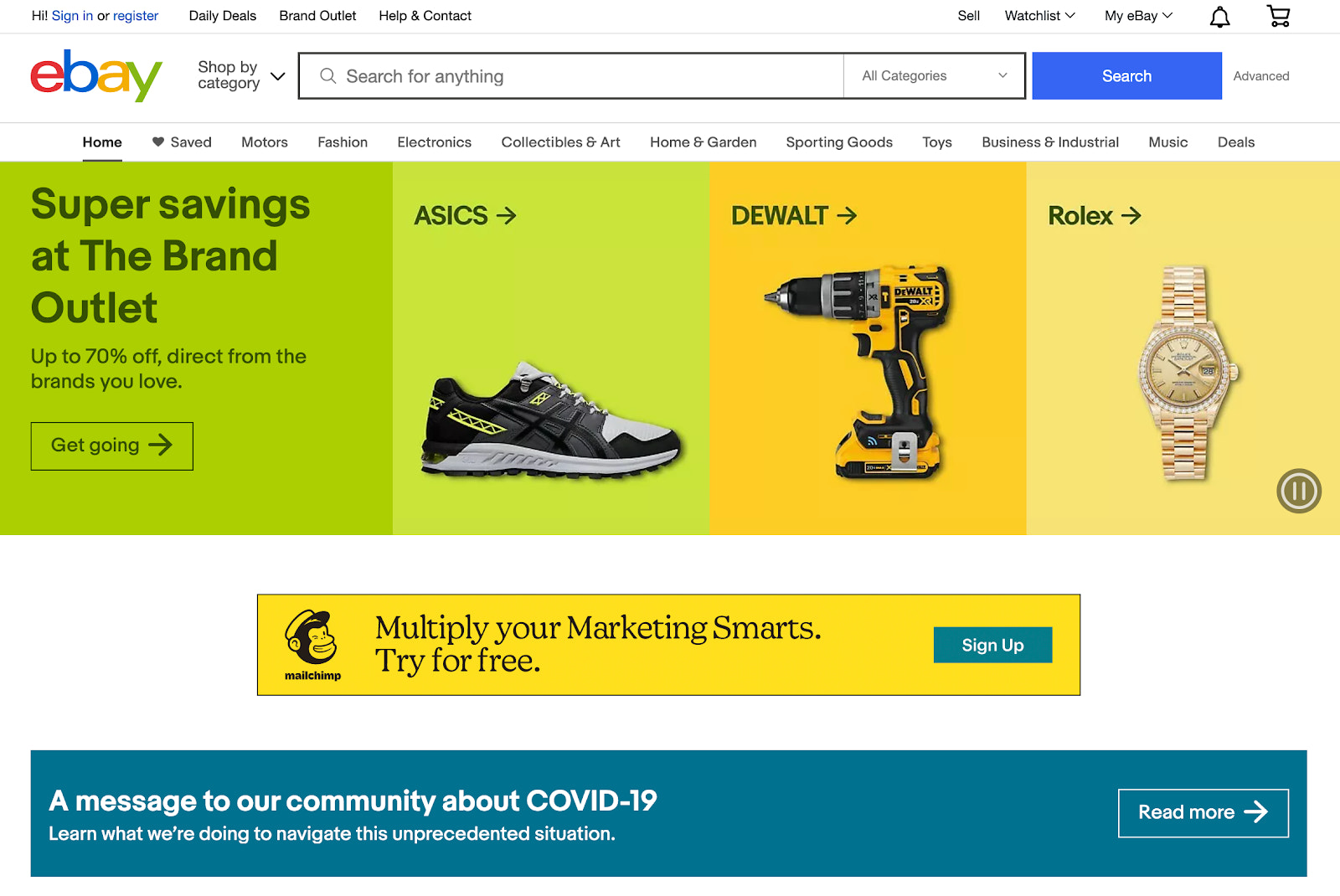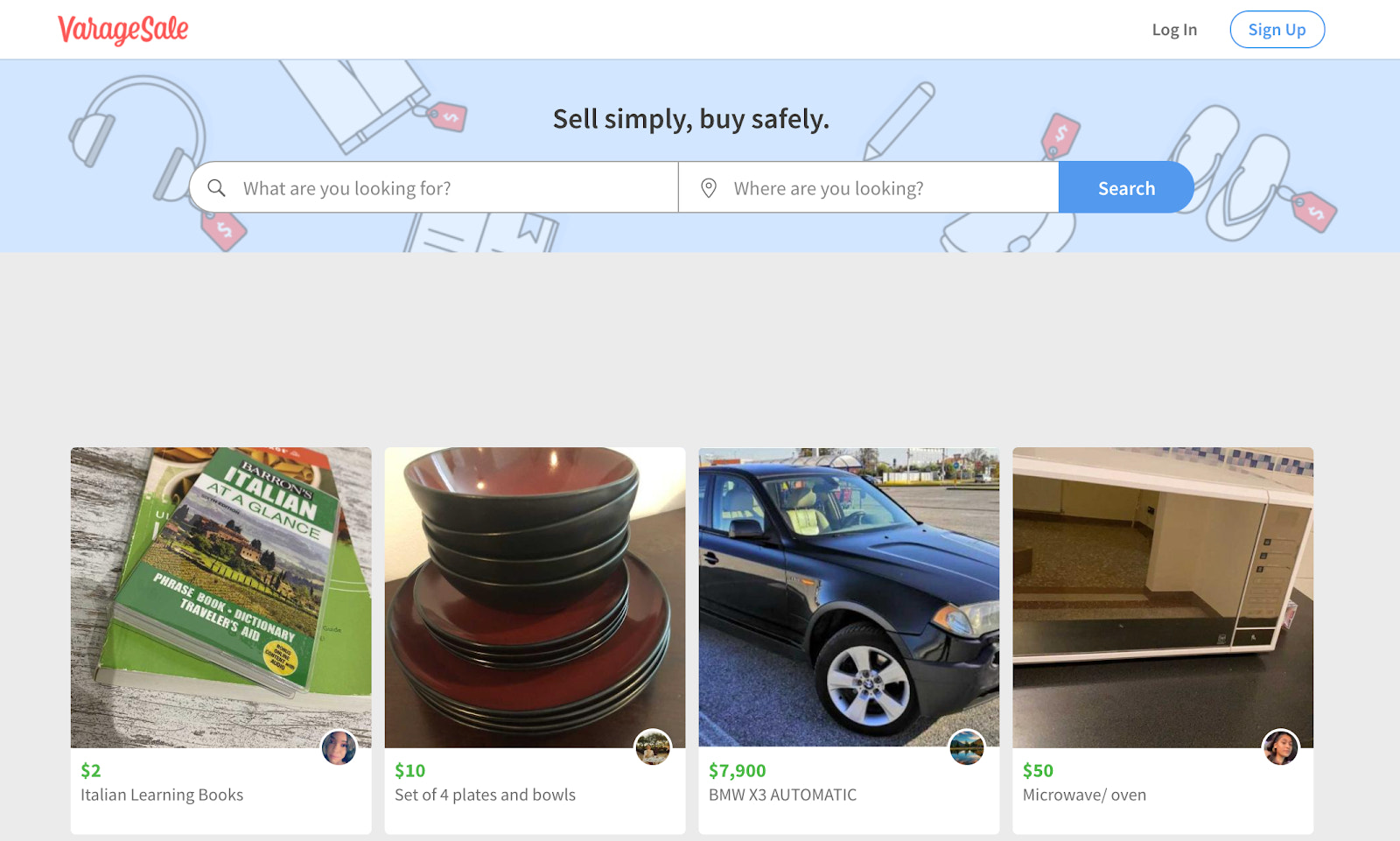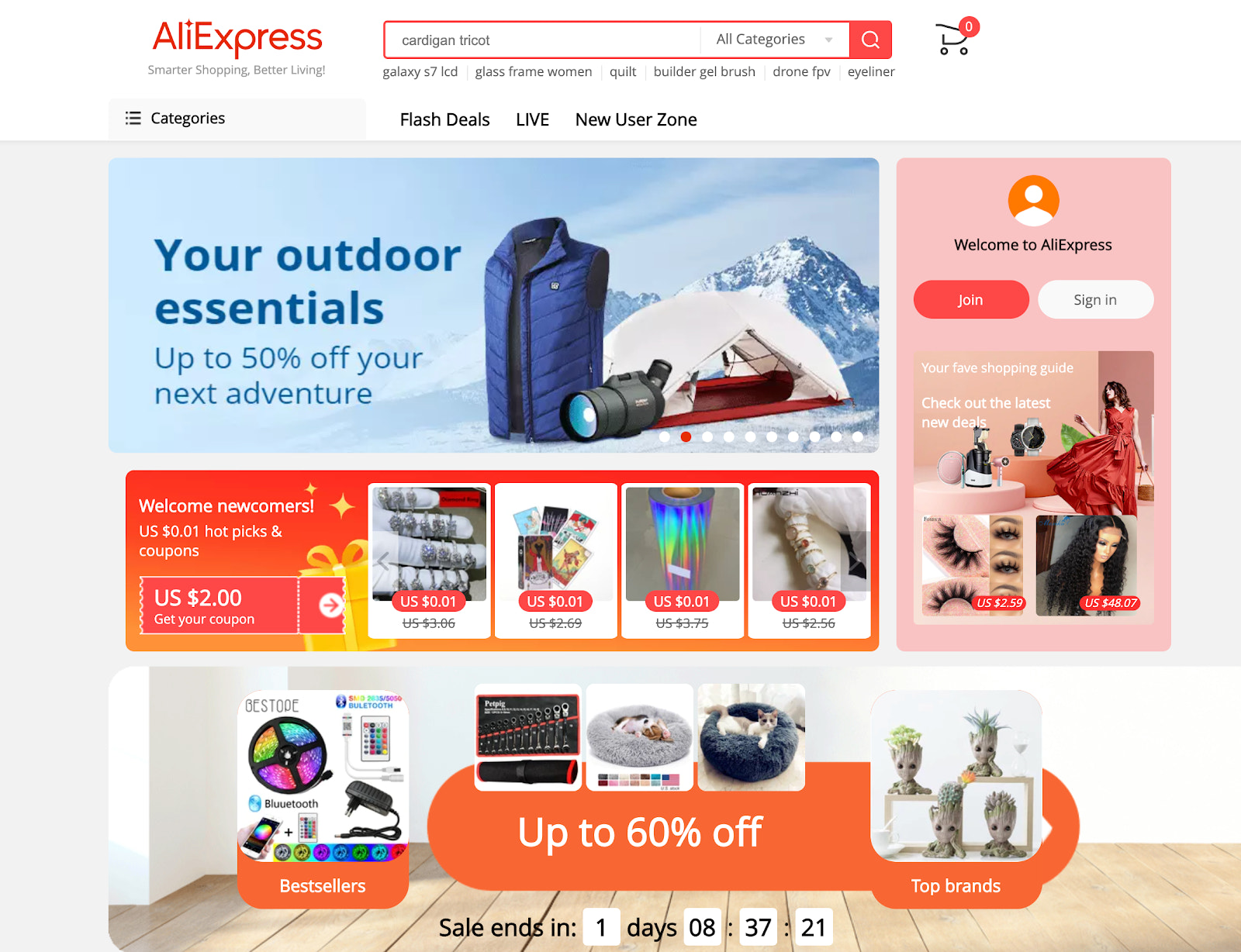20 Selling Sites and Marketplaces to Sell Your Stuff Online
The top online marketplaces in the world sold over $2 trillion in 2019, accounting for 57% of global web sales, according to Digital Commerce 360’s analysis.
The growth of marketplace sales leaves small business owners asking one question: to sell or not to sell on online marketplaces?
Today, there are hundreds of online selling sites you’ll come across when running an online business. Some are focused on specific niches, like video games and tech. Others allow retailers to sell anything from clothing to books to furniture and beyond.
While there are benefits to selling online through marketplaces, things like commissions and transactions fees tend to deter sellers from signing up.
In this guide, we’ll walk you through some of the best online selling sites, the benefits of starting your own online store, and how using both can help reach new customers and make more sales.
Explore this guide ?
Building your own store
Starting an online store may seem like a challenging task, but it can be rewarding and incredibly profitable when done right. The only drawback is that you have to market your own business and get people onto your site. Building a brand can also take some time.
The major advantage is that the profit is yours. You don’t pay endless fees on each sale or have to abide by any rules but your own. If this sounds interesting to you, here’s what you can do to build your own selling site.
Shopify

Shopify is the easiest and most reputable way to create your own store. It’s ecommerce website builder makes it easy to get up and running without tech skills or a huge budget. To date, Shopify powers over one million businesses and is known for its affordable prices, professional designs, and useful marketing tools.
If you want to build a Shopify store, you can choose from over 100 templates with built-in features. For a small $29 monthly fee, you get your own website, blog, SSL certifications, abandoned shopping cart recovery, and many other beginner-friendly marketing tools. You can sell stuff on your website, across multiple marketplaces like Amazon or eBay, and create personalized shopping experiences that lead to more sales.
Additionally, there are over 4,000 free Shopify apps you can use to extend your site’s functionality and successfully sell online. Use our Shopify Store Launch Checklist to get set up today.
Top US online selling sites
These marketplaces are popular with online sellers who want to sell any item and make extra money:
Amazon

As global ecommerce sales continue to grow, it’s no surprise to see Amazon on a top online marketplace list. As the top ecommerce company in the world, Amazon’s fiscal numbers show that it made $96.1 billion in revenue in the third quarter of 2020, a 37% increase from one year prior. It’s reported that Amazon sells over 400 products per minute, providing sellers with an active, built-in audience to sell to.
How has Amazon become the best online selling site? People have come to trust Amazon and the things they buy on its marketplace. Amazon is known to vet sellers and remove fake products. It also delivers items in as little as one day (in some areas) through Amazon Prime. And it has great prices and deals that people love, which is why they continue to do their online shopping there.
The cost to sell on Amazon depends on your plan, product category, fulfillment strategy, and other variables. At minimum, you’ll pay $39.99 per month for a Professional seller plan (plus the additional selling fees mentioned above). This plan is good if you want to sell more than 40 units per month, advertise your products, qualify for top placement on product detail pages, and need advanced selling tools like APIs and reporting.
Overall, Amazon is a good online marketplace to sell in if you want to reach a broad, global audience.
eBay

Chances are you’ve come across eBay once or twice in your day. It’s the original online selling site, having been online since 1995. EBay has over 1.3 billion listings and 182 million users worldwide, according to the latest eBay statistics.
You can sell anything on eBay, from everyday items like shoes and watches to weird stuff (yes, that’s a product category) like popcorn-scented pillows, bottles of air, and vintage ’70’s hand chairs.
If you plan to sell on eBay, take its selling fees into consideration. It charges a non-refundable listing fee for each product and another insertion fee if you list the same items in two different categories. It also charges a final value fee (usually between 10%–12%), calculated as a percentage of the total amount of the sale, including any shipping and handling charges.
Similar to Amazon, eBay has a massive audience you can sell to, fast, and can make a good additional sales channel for your online store.

Free Guide: How to Find a Profitable Product to Sell Online
Excited about starting a business, but not sure where to start? This free, comprehensive guide will teach you how to find great, newly trending products with high sales potential.
Get How To Find A Product To Sell Online: The Definitive Guide PDF delivered right to your inbox.
Almost there: please enter your email below to gain instant access.
We’ll also send you updates on new educational guides and success stories from the Shopify newsletter. We hate SPAM and promise to keep your email address safe.
Handshake

Handshake is a wholesale marketplace designed to easily connect suppliers with retailers. You’ll find unique, non-mass-produced products to sell in categories like fitness and yoga, jewelry, pets, and food and beverage. Each supplier is handpicked by the Handshake team.
Both online store owners and brick-and-mortar shops buy on Handshake. So if your business sells unique products in bulk (or you want to sell wholesale) apply to sell on Handshake.
The best part? Handshake integrates with Shopify. The integration allows wholesale creators to manage inventory, track sales, and fulfill orders all in one place, compared to traditional wholesale marketplaces, which requires manual upkeep and one too many CSV uploads and excel sheets.
Bonanza

Bonanza is a fast-growing online marketplace based in Seattle, Washington. It’s a newer buy and sell website, but is quickly becoming a popular eBay alternative. You can sell pretty much anything on the platform, and it receives over 5.1M monthly visits to its website, according to SimilarWeb.
Think of Bonanza as the middle ground between Amazon and eBay. There are more unique and handmade items for sale on Bonanza than on eBay, but fewer branded names than on Amazon. For example, you can sell the latest Nike Air Max model or a handmade one-of-a-kind copper necklace and find active buyers for each. Buyers can add products to their cart for a set price or negotiate an offer with you through the platform.
Bonanza charges you nothing to list your products on its site. It only takes a small percentage of your final sale price after you sell. And since many Bonanza sellers also have their own online stores, you can integrate Bonanza with platforms like Shopify to manage and sell products more easily.
Ruby Lane

Ruby Lane is a newer online marketplace for vintage and antiques, but it’s giving big sites like Etsy a run for their money. Ruby Lane was voted the number one recommended selling site for 2019 in an EcommerceBytes survey. Selling on Ruby Lane gives you access to highly targeted buyers for categories like antiques and collectibles, vintage and art, dolls, and jewelry.
Fees and payments are straightforward, too. It’s free to set up and list your products. But you need to pay a monthly maintenance fee of $54 for up to 50 items. This fee changes the more items you list on the platform. In addition, Ruby Lane charges a 6.7% service fee based on total purchase order, capped at $250.
Whether you’re an antiques and collectibles store owner or just want a website to sell stuff on, Ruby Lane is a good place to connect with passionate buyers.
Etsy

Etsy is the go-to marketplace for handcrafted and vintage items. In 2015, it began including maker-developed manufactured goods, but only for select accounts on the marketplace. As of Q2 2020, there were over 60 million buyers on Etsy, making it a lucrative way to start selling online.
You’ll be charged a $0.20 listing fee for each item you sell on Esty. Listings expire every four months. So if your item doesn’t sell and you renew the listing, you’ll be charged an additional $0.20. When you make a sale, you’ll be charged a transaction fee of 5% of the display price, plus the amount you charge for shipping and gift wrapping.
If you’re new to online selling, Etsy can be a great place to sell your stuff. You’ll get access to an active buyer network, a pop-up storefront, and tools to help market your business on the platform.
Chairish

Chairish is an online consignment shop made for high-quality home decor and furniture. It takes minutes to list an item (for free) on Chairish, and depending on your seller plan, between 70% and 80% of the selling price goes back to you.
The coolest thing about Chairish is that it’s totally free, unless you sign up for its Elite plan, which goes for $149 per month. You list your stuff, then Chairish’s curatorial team reviews your listings to ensure they meet the marketplace’s standards. Then they edit your product photos and take them live for you. They also handle shipping, so you never have to worry about logistics when selling on Chairish.
If you have design-oriented furniture or home decor to sell online, this is a good marketplace for you. It can quickly land your business in front of ideal collectors and buyers to make more sales online.
Swappa

Got an old iPhone X sitting around that you want to get rid of? Or a Ninthendo Switch you don’t play much anymore? Turn your tech into cash on Swappa, a trustworthy buy and sell website for phones, laptops, cameras, and more.
Swappa is legit because it does an excellent job vetting the products that get sold on the marketplace. It doesn’t allow any junk products, meaning everything you sell must be in good working condition, and each payment is protected by PayPal.
There are no fees to create a listing, but, you can choose to have your items featured (like an ad) for a $5 fee. Swappa only charges flat fees that are built into the price of your listing. When you make a sale, the buyer pays for the fee with their purchase. Swappa has some of the lowest fees around. For example, if you sell a $350 phone, Swappa only charges the buyer $15.
Local online selling sites
If you plan to sell in your community, here are the top free online selling websites to sell stuff locally:
Facebook Marketplace

Facebook Marketplace is a place where individual people can discover, buy, and sell items on Facebook. More than one in three people use Marketplace each month, offering a huge opportunity for sellers to reach an active audience. It’s completely free to list, and Facebook takes no fees, but there are guidelines you need to follow to sell on the platform.
Facebook has also partnered with platforms like Shopify to let merchants show their inventory, advertise items, and find new customers for their business.
Craigslist

Craigslist is one of the earlier online selling sites. Started in 1995 by Craig Newmark, it began as an email distribution list between friends featuring local events in the San Francisco Bay Area. It quickly became a web-based marketplace and, over the years, has expanded into 700 cities across 70 different countries. It’s free, easy, and pretty basic. It’s essentially a big local forum with a lot of stuff.
Craigslist is a higher-risk online marketplace. Because of the platform’s “hands-off” approach to buying and selling, scams can happen easily, and if they do, you don’t get any help from the company.
Regardless, Craigslist is a go-to selling site for local buyers and sellers and those who prefer to meet in person to close a deal.
Nextdoor

Nextdoor is similar to Facebook Marketplace and Craigslist because it’s focused on community selling. Nextdoor also enables the “friendly neighbor” feel by letting people post about what’s going on in their neighborhood—whether it’s traffic delays or restaurant recommendations. It acts as the hub for any given area.
Nextdoor also offers a free forum to sell your items online. It’s similar to Facebook Marketplace: there are no listing fees, and you’ll have to meet buyers in person. It feels a little safer too, because you need to make an account before you can access the platform.
VarageSale

VarageSale is a virtual garage sale buy and sell app. It was started in Toronto by an ex-elementary-school teacher fed up with scams and fake listings on other classified sites. VarageSale user profiles are based on real identities—everyone goes through a manual review process before you’re allowed to buy or sell.
Buyers can browse seller ratings and message sellers to connect before making the sale. They can ask questions or buy and schedule pick-up right in the app. People sell everything including furniture, clothing, shoes, and more on VarageSale. It’s also free for members to buy and sell on the app.
Shopify Academy Course: Sell Your Homemade Goods Online
Have a product you’re ready to sell? The Kular family shares their experience building a business around Mom’s recipe book, from selling one-on-one to reaching the aisles of Whole Foods.
Best global online selling sites
Want to sell to an international audience? Here are the best platforms to sell online around the world:
AliExpress

Founded in 2010, AliExpress is Alibaba’s cross-border ecommerce marketplace, with users from over 230 countries and nearly 20 million visitors daily. Users of the platform can sell to individual people or businesses, whether they are manufacturing products or adding an AliExpress dropshipping model to their online store.
AliExpress takes between 5% and 8% of commission fees for each transaction, depending on your product category. Otherwise, there are no overhead or arrangement fees to sell on the platform.
Taobao
Taobao began as an online selling site like eBay, in 2003, and has become the largest online marketplace in the world, according to research from Digital Commerce 360.
As of September 2020, Taobao recorded over 70 million MAUs and transacted more than $526 billion in gross merchandise volume during the 2020 fiscal year.
If you want to sell products that are not in Taobao or AliExpress, see this full list of online marketplaces in China.
OTTO

Otto is the second biggest online selling site in Germany, with a focus on fashion and lifestyle products. It grew from a post-war mail-order company selling just 28 types of shoes to a brand with over 1,000 employees and annual turnover of $61 million by 1959.
Today, over 90% of OTTO’s products are sold online, including branded products and goods from third-party retailers. The marketplace has nearly 9.4 million active customers and is second only to Amazon in the country.
Rakuten

Rakuten is a massive marketplace based out of Japan that provides ecommerce, banking, communications services, and more. Although its competitor PayPay Mall sees more monthly traffic, some sources claim Rakuten is the market leader by sales. Similar to marketplaces like Amazon, you can sell in endless product categories, including clothing, books, sports, subscription boxes, and more.
To date, Rakuten has over 50,000 merchants and 115 million global customers. Businesses who want to sell on Rakuten need to be registered in the United States or Japan, otherwise, you’ll have to use a service partner and apply through them.
For more information on Japanese selling sites, check out Selling in Japan: E-Commerce Landscape in Japan 2019.

Free Video Series: Ecommerce Inspiration
Feeling uninspired? Watch some of the world’s most successful entrepreneurs share their best advice for new business owners.
Get our Ecommerce Inspiration video series delivered right to your inbox.
Almost there: please enter your email below to gain instant access.
We’ll also send you updates on new educational guides and success stories from the Shopify newsletter. We hate SPAM and promise to keep your email address safe.
Mercado Libre

Mercado Libre is the most popular ecommerce marketplace in Latin America, serving over 18 countries, from Mexico to Argentina.
The brand’s combined revenue (between ecommerce and Fintech) surpassed $4.3 billion in Q3 2020, according to Mercardo Libre’s recent investor report. It also did over $18.2 billion in gross merchandise volume and sold nearly 600 million items in the same quarter. Sellers on the platform can merchant many types of products from 20 main categories and 123 smaller categories.
Flipkart

Flipkart started as an online bookstore in 2007 and has become the largest online selling site in India. Retailers can sell anything on Flipkart, including consumer elections, fashion, home essentials, groceries, and lifestyle products.
A direct Amazon competitor, Walmart-backed Flipkart continues to lead ecommerce market share in India. During the mid-October to mid-November 2020 holiday season, Flipkart comprised 66% of all gross merchandise value recorded by ecommerce firms, according to recent news. If you want to break into the Indian market, Flipkart is the best online selling site for your business.
If you plan to sell products not listed on Flipkart, explore the top 10 ecommerce sites in India.
MyDeal

MyDeal is an Australian marketplace offering over one million products across 3,500 categories, welcoming over 5.4 million visitors per month. It’s strictly a marketplace, meaning it doesn’t sell products of its own, only those from third-party sellers.
While you can sell products in various categories, the platform tends to focus on furniture, homewares, and other big items. MyDeal doesn’t offer any fulfillment services, so sellers must coordinate their own shipping or use an outside logistics company.
Want to sell products not found on MyDeal? Read about the top Australian marketplaces to sell on.
Finding the best ways to sell stuff online
Every online business owner should explore different online selling sites, regardless of whether you’re running a dropshipping store or selling custom products. Sometimes they can help new businesses get off the ground with a built-in audience of active buyers and marketing opportunities.
Regardless, it’s important to not rely only on online marketplaces. You’ll want to create your own online store to build your brand, connect with shoppers, and retain more profits. With a digital home base, you’ll stop paying out commissions and fees to each online selling site and grow your business for the long-term.
Ready to create your first business? Start your free 14-day trial of Shopify—no credit card required.
Online Selling FAQ
How can I start selling online?
- Use an ecommerce platform to create your own online store.
- Become an individual seller on existing online selling platforms like Amazon, eBay, or Etsy.
- Sell on social media platforms like Facebook and Instagram.
- Start a dropshipping business.
- Sell old stuff through a resale app like decluttr or VarageSale.
How can I sell my stuff online?
There are many different places sell online, including:
- Your own store
- Amazon
- eBay
- Etsy
- Bonanza
- Facebook Marketplace
- Rakuten
- Handshake
Where can I sell my stuff online for free?
- Facebook Marketplace
- Craigslist
- Nextdoor
- VarageSale
What is the best site to sell stuff locally?
- Start your own clothing line
- Launch a dropshipping store
- Flip your thrift store finds
- Publish a book on Amazon Kindle
- Start a blog
- Become an influencer
- Launch a podcast
- Build apps and websites
- Create handmade goods
- Curate subscription boxes


